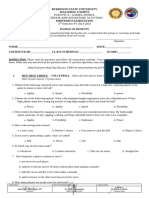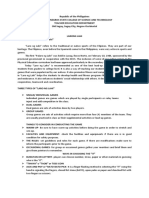0 ratings0% found this document useful (0 votes)
988 viewsSipa Larong Lahi
Sipa is a traditional Philippine sport that is played by kicking a ball. It can be played individually or in teams, and the aim is to kick the ball back and forth over a net. Sipa dates back to the 15th century before Spanish colonization, and was considered the national sport until 2009 when it was replaced by Arnis. The game is played by two teams on a tennis-sized court, with the objective being to kick the rattan, cane or wicker ball to the opposing side without it touching the ground. Core skills for Sipa include speed, agility and ball control.
Uploaded by
shine0628Copyright
© © All Rights Reserved
Available Formats
Download as PPTX, PDF, TXT or read online on Scribd
0 ratings0% found this document useful (0 votes)
988 viewsSipa Larong Lahi
Sipa is a traditional Philippine sport that is played by kicking a ball. It can be played individually or in teams, and the aim is to kick the ball back and forth over a net. Sipa dates back to the 15th century before Spanish colonization, and was considered the national sport until 2009 when it was replaced by Arnis. The game is played by two teams on a tennis-sized court, with the objective being to kick the rattan, cane or wicker ball to the opposing side without it touching the ground. Core skills for Sipa include speed, agility and ball control.
Uploaded by
shine0628Copyright
© © All Rights Reserved
Available Formats
Download as PPTX, PDF, TXT or read online on Scribd
You are on page 1/ 10
Sipa
(from the Tagalog word ‘to kick’) is a favorite
traditional sport in the Philippines. Both boys and girls play
this sport.
A single person can play sipa by himself or herself, but there
are moves to standardize the game with rules and teams.
Sipa is related to the Indonesian/Malaysian game sepak
takraw, and the sports authorities are trying to
develop sipa into a team sport to be played with a net
as sepak takraw is, but that is not how Filipino children
traditionally play it.
Filipinos started playing Sipa in the 15th century before the
Philippines was colonised by Spain. Sipa was even
considered the Philippines’ national sport before Arnis
replaced it in 2009 during the administration of former
President Gloria-Macapagal Arroyo.
RULES
The game is played on a court surface, about the size of a modern day
tennis court, either indoors or outdoorsa – by 2 teams consisting of 1, 2
or 4 players on each side. The aim is to kick the ball (rattan, cane, and
wicker) back and forth over a high rise net in the middle of the court.
Sipa is thrown upwards for the
player toss using only the leg,
particularly the area from the
foot until above the knee.the
player must prevent the Sipa
touching the ground by hitting
it several times. Each hit is
counted the player kicking the
Sipa most wins the game.
Basic skills
In the traditional and native
Philippine sport Sipa, the skills
necessary are SPEED,
AGILITY, and the ABILITY to
control the ball.
Euipments used
• A metal stud
• Coin-like object
• Covered with cloth or a
bunch of rubber-bands or
colourful threads
attached to it, usually
plastic straw.
You might also like
- Physical Education: Philippine Traditional Games and Sports100% (1)Physical Education: Philippine Traditional Games and Sports16 pages
- This Study Resource Was: Republic of The Philippines Leyte Normal University Tacloban CityNo ratings yetThis Study Resource Was: Republic of The Philippines Leyte Normal University Tacloban City6 pages
- P E and Health 12: Recreational Activties Philippine Games (Sipa)No ratings yetP E and Health 12: Recreational Activties Philippine Games (Sipa)11 pages
- Facilities and Equipment in Athletics Jumping EventsNo ratings yetFacilities and Equipment in Athletics Jumping Events6 pages
- Topic - DISCUSSION 3 (TRADITIONAL DANCES)No ratings yetTopic - DISCUSSION 3 (TRADITIONAL DANCES)16 pages
- Lesson Plan in Throwing Events in AthleticsNo ratings yetLesson Plan in Throwing Events in Athletics5 pages
- Volleyball-A: Team Sport Summer Olympic GamesNo ratings yetVolleyball-A: Team Sport Summer Olympic Games8 pages
- Grade 9 - Physical Education, Q1, Module 3No ratings yetGrade 9 - Physical Education, Q1, Module 327 pages
- SOFTBALL Detailed Lesson Plan in Physical Education 11No ratings yetSOFTBALL Detailed Lesson Plan in Physical Education 1112 pages
- History of Physical Education in The PhilippinesNo ratings yetHistory of Physical Education in The Philippines13 pages
- Bordon Is A Parlor Game Usually Played After Prayers For The Dead or During Wakes. Any Number ofNo ratings yetBordon Is A Parlor Game Usually Played After Prayers For The Dead or During Wakes. Any Number of7 pages
- Lesson 1 - Filipino Traditional Games (Laro NG Lahi)No ratings yetLesson 1 - Filipino Traditional Games (Laro NG Lahi)49 pages
- Physical Education Definition Historical Background and ContributorsNo ratings yetPhysical Education Definition Historical Background and Contributors6 pages
- Individual and Dual Sports: Roberto B. Dionisio Alfredo A. JulioNo ratings yetIndividual and Dual Sports: Roberto B. Dionisio Alfredo A. Julio52 pages



























































